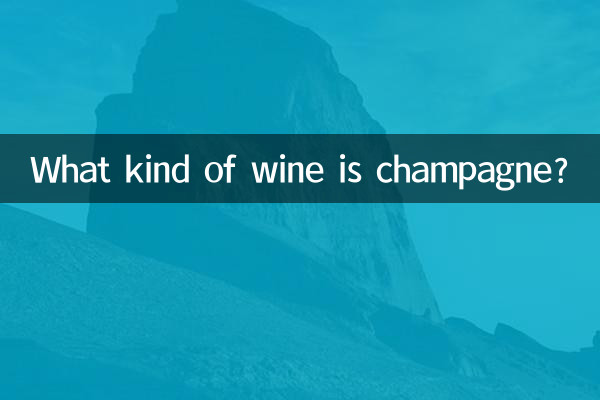What kind of wine is champagne?
Champagne is a highly regarded sparkling wine, but many people don’t fully understand its classification and characteristics. This article will delve into the definition, classification, production process, and differences between Champagne and other sparkling wines to help you better understand this elegant drink.
1. The definition of champagne

Champagne is a sparkling wine produced in the Champagne region of France. According to French law, only sparkling wine produced using specific methods in the region can be called "Champagne." This name is strictly protected by law and similar products in other regions can only be called "sparkling wine".
| key features | Description |
|---|---|
| Origin | French Champagne region |
| Grape varieties | Mainly Chardonnay, Pinot Noir and Pinot Meunier |
| brewing method | Traditional method (Champagne method), secondary fermentation takes place in the bottle |
| alcohol content | Usually around 12% |
2. Classification of Champagne
Champagne can be classified based on sweetness, color and grape varieties used, with each type having its own unique flavor profile.
| Classification criteria | Type | Features |
|---|---|---|
| According to sweetness | Brut Nature | Very low sugar content, 0-3g/L |
| Extra Brut | 0-6g/L | |
| Brut | The most common type, containing less than 12 g/L of sugar | |
| by color | white champagne | Usually made from Chardonnay, light golden color |
| rosé champagne | Achieve pink color by mixing red and white wine or maceration | |
| By grape variety | Blanc de Blancs | 100% Chardonnay, fresh and elegant |
| Blanc de Noirs | Made from Pinot Noir or Pinot Meunier, the wine is fuller-bodied |
3. Champagne production process
Champagne is produced using the traditional method (Methode Champenoise). This process is complex and time-consuming, but it can produce fine and long-lasting bubbles.
The main steps include:
1. Base wine brewing: first brew static wine
2. Blending: blending wines from different years, grape varieties and plots
3. Bottling: Add sugar and yeast for secondary fermentation
4. Aging: The wine must be in contact with the lees for at least 15 months (non-vintage wine) or 3 years (vintage wine)
5. Spinner bottle: The sediment is collected at the mouth of the bottle through a special method
6. Removal of residue: remove sediment after freezing the bottle mouth
7. Rehydration: Add wine and sugar to adjust the final sweetness
8. Sealing: final packaging
4. The difference between champagne and other sparkling wines
While sparkling wine is produced all over the world, Champagne has its own unique characteristics:
| Compare items | champagne | Other sparkling wines |
|---|---|---|
| Origin | French Champagne region | Other production areas (such as Spanish Cava, Italian Prosecco) |
| brewing method | traditional law | May use Charmat or other methods |
| Grape varieties | Limited variety | Special varieties from various places |
| price | usually higher | Generally more friendly to the people |
| Bubble characteristics | Delicate and long-lasting | May be rough |
5. How to Taste Champagne
When tasting Champagne, you need to pay attention to the following aspects:
1.temperature: Optimal drinking temperature is 8-10°C
2.wine glass:Use tulip cup or flute cup
3.observe: Pay attention to the fineness and persistence of bubbles
4.smell the fragrance: Identifies the aroma of yeast, bread, fruit, etc.
5.Taste: Feel the balance of acidity, body and aftertaste
6. Champagne food pairing suggestions
Champagne is an excellent food pairing choice due to its high acidity and sparkling properties:
| Champagne type | Suitable for matching |
|---|---|
| Brut white champagne | Oysters, caviar, light seafood |
| Blanc de Blancs | White meat, cream sauce dishes |
| rosé champagne | Duck, smoked salmon |
| sweet champagne | Fruit desserts, cream cakes |
Conclusion
As a special type of sparkling wine, Champagne enjoys a high status among world wines due to its unique origin, strict technology and diverse styles. Understanding the classification and characteristics of Champagne can not only enhance the tasting experience, but also demonstrate professional wine knowledge in social situations. Whether celebrating a special occasion or pairing it with gourmet food, a fine Champagne always makes for a delightful experience.

check the details

check the details